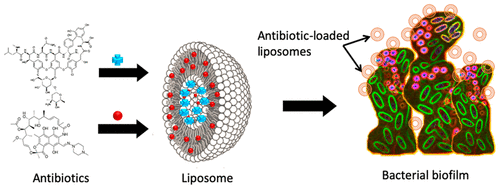当前位置:
X-MOL 学术
›
ACS Infect. Dis.
›
论文详情
Our official English website, www.x-mol.net, welcomes your
feedback! (Note: you will need to create a separate account there.)
Liposomes for Antibiotic Encapsulation and Delivery.
ACS Infectious Diseases ( IF 4.0 ) Pub Date : 2020-04-07 , DOI: 10.1021/acsinfecdis.9b00357 Azucena Gonzalez Gomez 1 , Zeinab Hosseinidoust 1, 2
ACS Infectious Diseases ( IF 4.0 ) Pub Date : 2020-04-07 , DOI: 10.1021/acsinfecdis.9b00357 Azucena Gonzalez Gomez 1 , Zeinab Hosseinidoust 1, 2
Affiliation

|
When antibiotics are administered, orally or intravenously, they pass through different organs and layers of tissue on their way to the site of infection; this can cause dilution and/or intoxication. To overcome these problems, drug delivery vehicles have been used to encapsulate and deliver antibiotics, improving their therapeutic index while minimizing their adverse effects. Liposomes are self-assembled lipid vesicles made from at least one bilayer of phospholipids with an inner aqueous compartment. Liposomes are attractive vehicles to deliver antibiotics because they can encapsulate both hydrophobic and hydrophilic antibiotics, they have low toxicity, and they can change the biodistribution of the drug. Furthermore, liposomes have been approved by regulatory agencies. However, most developmental and mechanistic research in the field has been focused on encapsulation and delivery of anticancer drugs, a class of molecules that differ significantly in chemistry from antibiotics. In this critical Review, we discuss the state of knowledge regarding the design of liposomes for encapsulation and delivery of antibiotics and offer insight into the challenges and promises of using liposomes for antibiotic delivery.
中文翻译:

用于抗生素封装和递送的脂质体。
当口服或静脉内施用抗生素时,它们在到达感染部位的途中会经过不同的器官和组织层。这可能导致稀释和/或中毒。为了克服这些问题,已经使用了药物递送载体来封装和递送抗生素,从而在降低其副作用的同时改善了它们的治疗指数。脂质体是自组装的脂质囊泡,由至少一层具有内部水室的磷脂双层制成。脂质体是递送抗生素的有吸引力的载体,因为它们可以包裹疏水性和亲水性抗生素,它们毒性低,并且可以改变药物的生物分布。此外,脂质体已被监管机构批准。然而,该领域中大多数的开发和机理研究都集中在抗癌药的封装和递送上,这是一类化学性质与抗生素明显不同的分子。在这篇重要的综述中,我们讨论了有关用于封装和递送抗生素的脂质体设计的知识状态,并深入了解了使用脂质体进行抗生素递送的挑战和希望。
更新日期:2020-03-25
中文翻译:

用于抗生素封装和递送的脂质体。
当口服或静脉内施用抗生素时,它们在到达感染部位的途中会经过不同的器官和组织层。这可能导致稀释和/或中毒。为了克服这些问题,已经使用了药物递送载体来封装和递送抗生素,从而在降低其副作用的同时改善了它们的治疗指数。脂质体是自组装的脂质囊泡,由至少一层具有内部水室的磷脂双层制成。脂质体是递送抗生素的有吸引力的载体,因为它们可以包裹疏水性和亲水性抗生素,它们毒性低,并且可以改变药物的生物分布。此外,脂质体已被监管机构批准。然而,该领域中大多数的开发和机理研究都集中在抗癌药的封装和递送上,这是一类化学性质与抗生素明显不同的分子。在这篇重要的综述中,我们讨论了有关用于封装和递送抗生素的脂质体设计的知识状态,并深入了解了使用脂质体进行抗生素递送的挑战和希望。











































 京公网安备 11010802027423号
京公网安备 11010802027423号